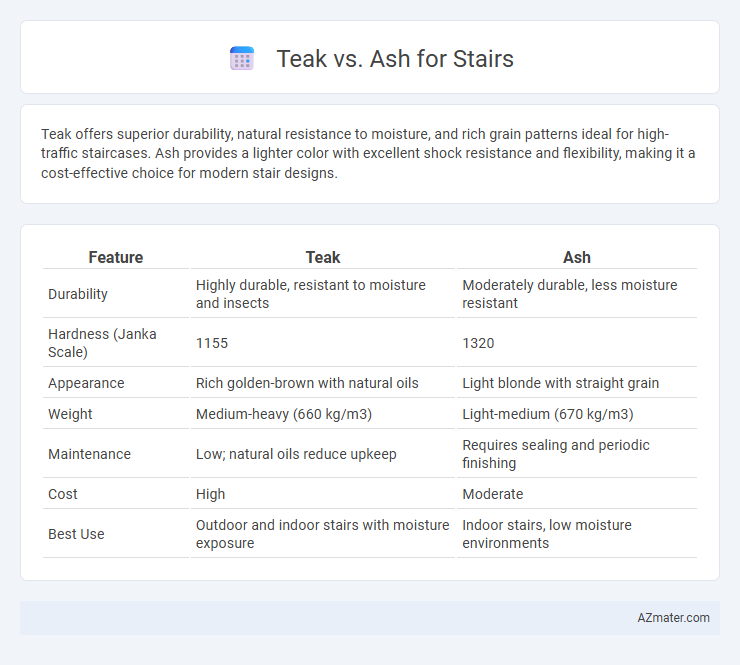Teak offers superior durability, natural resistance to moisture, and rich grain patterns ideal for high-traffic staircases. Ash provides a lighter color with excellent shock resistance and flexibility, making it a cost-effective choice for modern stair designs.
Table of Comparison
| Feature | Teak | Ash |
|---|---|---|
| Durability | Highly durable, resistant to moisture and insects | Moderately durable, less moisture resistant |
| Hardness (Janka Scale) | 1155 | 1320 |
| Appearance | Rich golden-brown with natural oils | Light blonde with straight grain |
| Weight | Medium-heavy (660 kg/m3) | Light-medium (670 kg/m3) |
| Maintenance | Low; natural oils reduce upkeep | Requires sealing and periodic finishing |
| Cost | High | Moderate |
| Best Use | Outdoor and indoor stairs with moisture exposure | Indoor stairs, low moisture environments |
Introduction: Comparing Teak and Ash for Stairs
Teak offers exceptional durability and natural resistance to moisture and pests, making it ideal for high-traffic staircases in humid environments. Ash provides a lighter, more affordable option with excellent shock resistance and a striking grain pattern that enhances modern interior aesthetics. Both woods balance strength and beauty, but Teak's longevity and low maintenance often position it as the premium choice for stair construction.
Appearance and Grain: Teak vs Ash
Teak wood features a rich golden-brown color with a straight grain pattern that often includes subtle waves, providing a luxurious and warm appearance ideal for stairs. Ash wood presents a lighter, creamy to pale brown hue, with a distinctive open grain and pronounced cathedral patterns, adding a visually striking and textured look to staircases. The natural durability of teak complements its elegant grain, whereas ash offers a bright, airy aesthetic that enhances contemporary stair designs.
Durability and Strength Comparison
Teak offers exceptional durability and natural resistance to moisture, insects, and rot, making it an ideal choice for stairs exposed to heavy use or varying environmental conditions. Ash provides excellent strength and is known for its shock resistance and flexibility, but it requires proper sealing to maintain its durability over time. When comparing both, teak typically outperforms ash in long-term durability due to its dense oil content, though ash offers superior impact resistance and a slightly lighter weight for stair construction.
Resistance to Moisture and Decay
Teak offers exceptional resistance to moisture and decay due to its natural oils and dense grain, making it an ideal choice for stairs in humid or outdoor environments. Ash, while moderately durable, is more susceptible to moisture absorption and may require additional treatments to prevent decay and warping over time. Choosing teak ensures long-lasting durability and reduced maintenance in moisture-prone areas compared to ash.
Workability and Ease of Installation
Teak offers exceptional workability due to its natural oils, which make it resistant to warping and easy to shape with hand and power tools, ideal for complex stair designs. Ash is highly malleable, allowing smooth cuts and precise joins, improving installation speed and accuracy on staircases. Both woods provide a balanced combination of durability and ease of handling, but teak's resistance to moisture gives it an edge in longevity for stair applications.
Maintenance Requirements: Teak vs Ash
Teak stairs require minimal maintenance due to their natural oils, which resist moisture, insects, and decay, making them ideal for high-traffic or humid environments. Ash stairs need more frequent sealing and polishing to prevent wear and moisture damage because they lack these natural oil properties. Regular maintenance for ash includes sanding and applying protective finishes, while teak primarily benefits from occasional cleaning and oiling to preserve its durability and appearance.
Cost Differences Between Teak and Ash
Teak wood commands a higher price than ash due to its natural durability, resistance to moisture, and rich golden-brown color, making it a premium choice for stairs. Ash offers a more budget-friendly option with its lighter hue and good strength, though it lacks teak's superior longevity and weather resistance. The cost difference reflects teak's scarcity and superior performance, often making ash the preferred material for affordable stair solutions without compromising basic quality.
Environmental Impact and Sustainability
Teak offers exceptional durability and resistance to pests, reducing the need for chemical treatments, but its slow growth rate and often tropical sourcing raise concerns about deforestation and habitat loss. Ash, sourced from fast-growing temperate forests, supports sustainable forestry practices and regenerates quickly, making it a more environmentally friendly option for stairs. Choosing FSC-certified ash ensures responsible harvesting with minimal ecological impact compared to teak's higher environmental footprint.
Best Applications: When to Choose Teak or Ash
Teak is best suited for stairs in outdoor or high-moisture environments due to its exceptional water resistance, durability, and natural oils that prevent decay and insect damage. Ash is ideal for indoor staircases where strength, flexibility, and a lighter, more uniform appearance are desired, offering excellent shock resistance and easy stainability for a refined finish. Choose teak for longevity in challenging conditions and ash for cost-effective elegance and structural resilience in dry, indoor settings.
Final Verdict: Which Wood is Better for Stairs?
Teak offers exceptional durability, natural resistance to moisture and insects, making it ideal for high-traffic staircases in humid environments. Ash, known for its impressive strength and light color, provides a more affordable, visually appealing option suitable for indoor stairs with moderate use. For longevity and minimal maintenance, teak is superior, while ash excels in cost-effectiveness and aesthetic versatility on interior stairs.

Infographic: Teak vs Ash for Stair
 azmater.com
azmater.com